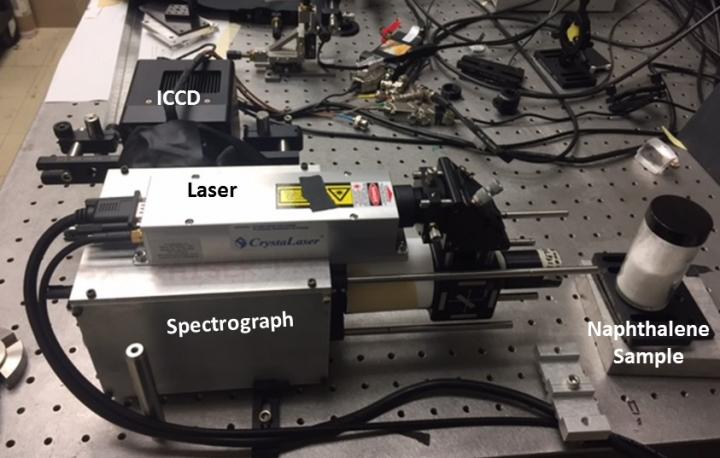
Thanks to a carefully designed optical setup, the new standoff ultra-compact micro Raman (SUCR) instrument can perform microscopic Raman analysis of samples 10 centimeters away from the instrument with 17.3-micron resolution. M. Nurul Abedin, NASA Langley Research Center
NASA has developed an innovative new spectroscopy instrument to aid the search for extraterrestrial life. The new instrument is designed to detect compounds and minerals associated with biological activity more quickly and with greater sensitivity than previous instruments. Although no evidence of life outside of Earth has yet been found, looking for evidence of present or past life on other planets continues to be an important part of the NASA Planetary Exploration Program.
Researchers at NASA Langley Research Center and the University of Hawaii developed the new instrument, which improves on an analytical technique known as micro Raman spectroscopy. This technique uses the interaction between laser light and a sample to provide chemical composition information on a microscopic scale. It can detect organic compounds such as the amino acids found in living things and identify minerals formed by biochemical processes on Earth that might indicate life on other planets.
“Our instrument is one of the most advanced Raman spectrometers ever developed,” said M. Nurul Abedin of NASA Langley Research Center, who led the research team. “It overcomes some of the key limitations of traditional micro Raman instruments and is designed to serve as an ideal instrument for future missions that use rovers or landers to explore the surface of Mars or Jupiter’s icy Europa moon.”
In The Optical Society journal Applied Optics, the researchers report that their new system — which they call the standoff ultra-compact micro Raman (SUCR) instrument — is the first to perform micro-Raman analysis of samples 10 centimeters away from the instrument with 17.3-micron resolution. The new spectrometer is significantly faster than other micro Raman instruments and extremely compact. These features are important for space applications and could also make the instrument useful for real-time biomedical and food analyses.
“Micro Raman spectroscopy is being explored for detecting skin cancer without a biopsy and can be used to for food analysis applications such as measuring caffeine in drinks,” said Abedin. “Our system could be used for these applications and others to provide fast chemical analysis that doesn’t require sending samples off to a laboratory.”
Designing for space
Size and weight were important to consider when designing the SUCR instrument for space exploration. “We had to make sure the instrument was very small and light so that it could travel aboard a small, fuel-efficient spaceship that would make the nine-month journey to Mars or the six-year journey to Europa,” said Abedin. “The instrument must also work with other instruments aboard a rover or lander and be unaffected by the harsh radiation conditions found on other planets.”
The new instrument offers several important improvements to previous micro Raman spectroscopy instruments, which require samples to be collected prior to analysis and measurements to take place in the dark. Traditional micro Raman instruments are also prone to interference from natural mineral fluorescence.
“The limitations of current systems would significantly lower the number of samples and amount of information that could be gained from a mission to Mars, for example,” said Abedin. “We carefully designed the optics of our system to enable fast analysis under daylight conditions and to produce a strong Raman signal that isn’t as prone to interference as traditional systems.”
The SUCR instrument uses the direct coupled Raman system design previously developed at the University of Hawaii for remote chemical detection of samples over 100 meters away from the instrument in daylight (A.K. Misra et al, Spectrochim Acta A 2005). The University of Hawaii’s compact instrument connects all the optics directly to the spectrometer, which significantly improved performance compared to fiber-coupled Raman systems because less signal is lost.
To create the SUCR instrument, the researchers modified the collection optics of the previously developed system to acquire spectra of samples closer to the instrument. They also further reduced system’s footprint by using a miniaturized spectrometer just 16.5 centimeters long, 11.4 centimeters wide and 12.7 centimeters tall.
Passing light from a compact pulsed laser through a cylindrical lens with a focal length of 100 millimeters allowed the researchers to achieve 17.3-micron resolution for analysis of samples 10 centimeters away. They also demonstrated 10-micron resolution for samples 6 centimeters away using a cylindrical lens with a 60-millimeter focal length.
Fast analysis in room light on
In laboratory tests, the researchers used their SUCR instrument to successfully measure Raman spectra from samples 10 centimeters away with an analysis area of 17.3 microns by 5 millimeters. In room light on conditions, they used SUCR to analyze minerals and organic compounds that might be associated with life on other planets, including included sulfur, naphthalene, mixed samples, marble, water, calcite minerals and amino acids.
“We are now trying to increase the analysis area by using scanning,” said Abedin. “Because of the speed of our system, we think it will be possible to create a Raman map of an area 5 by 5 millimeters in only one minute. Doing this with a traditional micro Raman system would take several days.”
As a next step, the researchers plan to test their SUCR instrument in environments that mimic those found on Mars and other planets. They will then begin the validation process to show that the device would operate accurately under conditions found in space.




